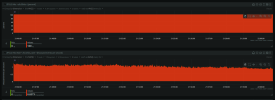Hello,
I stumbled across an Kingston DC1000B the other day, which I formatted to 4K sectors. I have no use for it since I already run mirrored SLOGs in my main PVE, but my PVE server are pretty slow, so I thought "why not".
This is some of the stats right now:
And this is my setup:
No I'm trying to figure out if it's better, the same, or worse. But a whole day of reading (this was very nice: https://klarasystems.com/articles/openzfs-all-about-l2arc/) didn't make me an expert.
Server has 32 GB RAM, and holds this much data:
So, what are you guys say in this? I know "buy more RAM!!" but yeah, if this is just sliiiightly better I think it's worth it. I got the NVME cheap.
I stumbled across an Kingston DC1000B the other day, which I formatted to 4K sectors. I have no use for it since I already run mirrored SLOGs in my main PVE, but my PVE server are pretty slow, so I thought "why not".
This is some of the stats right now:
Bash:
L2ARC size (adaptive): 120.8 GiB
Compressed: 6.7 % 8.1 GiB
Header size: 0.1 % 101.0 MiB
MFU allocated size: 58.1 % 4.7 GiB
MRU allocated size: 41.8 % 3.4 GiB
Prefetch allocated size: 0.2 % 16.4 MiB
Data (buffer content) allocated size: 0.0 % 0 Bytes
Metadata (buffer content) allocated size: 100.0 % 8.1 GiB
L2ARC breakdown: 1.9M
Hit ratio: 49.6 % 944.4k
Miss ratio: 50.4 % 958.5k
ARC total accesses: 18.3M
Total hits: 89.5 % 16.4M
Total I/O hits: 0.1 % 11.8k
Total misses: 10.5 % 1.9M
Bash:
NAME PROPERTY VALUE SOURCE
backupstorage secondarycache metadata localAnd this is my setup:
Bash:
NAME STATE READ WRITE CKSUM
backupstorage ONLINE 0 0 0
raidz2-0 ONLINE 0 0 0
ata-HGST_HUS726T6TALN6L4_V8redacted ONLINE 0 0 0
ata-HGST_HUS726T6TALN6L4_V8redacted ONLINE 0 0 0
ata-HGST_HUS726T6TALN6L4_V8redacted ONLINE 0 0 0
ata-HGST_HUS726T6TALN6L4_V8redacted ONLINE 0 0 0
ata-HGST_HUS726T6TALN6L4_V8redacted ONLINE 0 0 0
ata-HGST_HUS726T6TALN6L4_V8redacted ONLINE 0 0 0
ata-HGST_HUS726T6TALN6L4_V9redacted ONLINE 0 0 0
ata-HGST_HUS726T6TALN6L4_V9redacted ONLINE 0 0 0
ata-HGST_HUS726T6TALN6L4_V9redacted ONLINE 0 0 0
ata-HGST_HUS726T6TALN6L4_V9redacted ONLINE 0 0 0
logs
nvme-KINGSTON_SEDC1000BM8240G_50redacted644-part1 ONLINE 0 0 0
cache
nvme-KINGSTON_SEDC1000BM8240G_50redacted644-part2 ONLINE 0 0 0No I'm trying to figure out if it's better, the same, or worse. But a whole day of reading (this was very nice: https://klarasystems.com/articles/openzfs-all-about-l2arc/) didn't make me an expert.
Server has 32 GB RAM, and holds this much data:
Bash:
NAME SIZE ALLOC FREE CKPOINT EXPANDSZ FRAG CAP DEDUP HEALTH ALTROOT
backupstorage 54.6T 24.9T 29.6T - - 5% 45% 1.00x ONLINE -So, what are you guys say in this? I know "buy more RAM!!" but yeah, if this is just sliiiightly better I think it's worth it. I got the NVME cheap.
Last edited:



